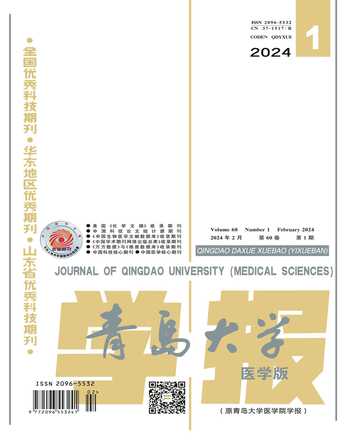不同阶段新型冠状病毒感染对医学生心理状况影响
王帅 张红梅 刘广燕 宋金莲 郝贵亮 刘成玉



[收稿日期]2023-02-23; [修订日期]2023-04-06
[基金项目]青岛大学2020年教学研究与改革项目(JXG-
G2020023);山东省高等医学教育研究中心科研规划课题(YJK-
T2021007)
[第一作者]王帅(1995-),男,硕士,初级检验技师。
[通信作者]刘成玉(1963-),男,教授,硕士生导师。E-mail:
lchyu2000@163.com。
[摘要] 目的
了解新型冠状病毒感染疫情(新冠疫情)不同阶段对医学生心理健康状况的影响,为采取相关心理干预措施提供依据。
方法 分别于2020年3月16日—3月22日的新冠病毒感染暴发期及2021年7月19日—7月25日的新冠病毒感染的常态化防控期,通过网络问卷平台发放SCL-90问卷,对医学生的心理健康状况进行调查,并与常模及同期的非医学生进行对比分析。
结果 暴发期间医学生的躯体化、强迫、抑郁、焦虑、恐怖及总均分均高于全国常模(t=2.293~12.426,P<0.05);医学生的焦虑均分显著高于非医学生,非医学生的恐怖均分显著高于医学生,女生的强迫均分高于男生,本科生的恐怖因子均分高于研究生(t=1.992~2.800,P<0.05)。常态化防控期间医学生的抑郁、焦虑及恐怖均分均高于全国常模(t=3.617~4.238,P<0.05),非医学生的抑郁、恐怖均分及GSI均显著高于医学生(t=2.444~3.003,P<0.05),本科医学生的躯体化因子分及总均分均高于研究生(t=3.384、3.639,P<0.05)。暴發期间医学生的躯体化、强迫、抑郁、精神病性、其他均分及总均分均显著高于防控期间(t=2.765~7.970,P<0.05)。同时,参与了前后两次调查的508名学生,其疫情暴发期间的躯体化、强迫、抑郁、焦虑、敌对、恐怖、偏执、精神病性、其他均分以及总均分,均显著高于常态化防控期间(t=2.634~64.516,P<0.05)。
结论 新冠疫情可导致医学生产生焦虑、抑郁及恐惧等不良心理反应,在疫情防控期间应采取积极的应对措施,尽早干预,对医学生的心理健康有积极意义。
[关键词] 应激,心理学;新型冠状病毒感染;学生,医科;调查和问卷
[中图分类号] R395;R563.12
[文献标志码] A
[文章编号] 2096-5532(2024)01-0137-04
doi:10.11712/jms.2096-5532.2024.60.025
[开放科学(资源服务)标识码(OSID)]
[网络出版] https://link.cnki.net/urlid/37.1517.R.20240326.1141.004;2024-03-28 16:07:20
Effects of SARS-CoV-2 infection on the psychological status of medical students at different stages
WANG Shuai, ZHANG Hongmei, LIU Guangyan, SONG Jinlian, HAO Guiliang, LIU Chengyu
\ (Clinical Laboratory of Qingdao Women and Childrens Hospital Affiliated to Qingdao University, Qingdao 266034, China)
\; [Abstract]\ Objective\ To investigate the impact of the severe acute respiratory syndrome coronavirus 2 (SARS-CoV-2) epidemic on the mental health status of medical students at different stages, and to provide a reference for psychological intervention.
Methods\ During the SARS-CoV-2 outbreak period of March 16 to March 22 in 2020 and the regular prevention and control period of July 19 to July 25 in 2021, the Symptom Checklist-90 (SCL-90) questionnaire was delivered through the online questionnaire platform to investigate the mental health of medical students for comparisons with the norm and non-medical students at the same time.
\ Results\ During the outbreak period, the medical students showed significantly higher mean scores of somatization, obsessive-compulsion, depression, anxiety, phobic anxiety, and the Global Severity Index (GSI) compared with the national norms (t=2.293-12.426,P<0.05); the mean anxiety score of the medical students was significantly higher than that of the non-medical students; the mean phobic anxiety score of the non-medical students was significantly higher than that of the medical students; the girls had a significantly higher mean obsessive-compulsion score than the boys; the mean score of phobic anxiety was significantly higher in the undergraduate students than in the graduate students (t=1.992-2.800,P<0.05). During the regular prevention and control period, the mean scores of depression, anxiety, and phobic anxiety of the medical students were significantly higher compared with the national norms (t=3.617-4.238, P<0.05); the mean scores of depression, phobic anxiety, and GSI of the non-medical students were significantly higher than those of the medical students (t=2.444-3.003,P<0.05); the mean scores of so-
matization and GSI were significantly higher in the undergraduate students than in the graduate students (t=3.384,3.639,P<0.05). For the medical students, the mean scores of somatization, obsessive-compulsion, depression, psychoticism, additional items, and GSI were significantly higher in the outbreak period than in the regular prevention and control period (t=2.765-7.970,P<0.05). Among the 508 students who responded to both surveys, the mean scores of somatization, obsessive-compulsion, depression, anxiety, hostility, phobic anxiety, paranoid ideation, psychoticism, additio-
nal items, and GSI were significantly higher during the outbreak period than during the regular prevention and control period (t=2.634-64.516,P<0.05).
\ Conclusion\ The SARS-CoV-2 epide-
mic can cause anxiety, depression, fear, and other psychological stress in medical students. During the epidemic prevention and control period, active measures should be taken as soon as possible to positively influence the mental health of medical students.
[Key words]\ stress, psychological; COVID-1; students, medica; surveys and questionnaires
新型冠狀病毒(新冠病毒)感染防控期间,医护人员因面对高强度的工作压力和高感染风险,其心理问题比较突出[1-4]。研究发现,在严重急性呼吸综合征(SARS)流行期间医学生心理障碍发生率较高[5-6]。因此,了解新冠病毒感染疫情(新冠疫情)暴发期间及常态化防控期间医学生的心理状况,并制定应对措施,对于医学生的成长是至关重要的。目前,有关疫情暴发期间和常态化防控期间医学生的心理状况变化的研究尚未见报道。因此,我们对青岛大学青岛医学院医学生的心理状况进行了调查,旨在为医学生心理障碍的早期预防、早期发现和早期干预提供依据。现将结果报告如下。
1 对象与方法
1.1 调查对象
本次共调查青岛大学医学生3 172名。其中,疫情暴发期间(A组)1 666名,年龄(21.29±2.02)岁;本科生1 396名,研究生270名;男生701名,女生965名。常态化防控期间(B组)1 506名,年龄(21.39±2.01)岁;本科生1 268名,研究生238名;男生662名,女生844名。同时,以同期的非医学专业的学生作为对照。其中,疫情暴发期间(C组)812名,年龄(21.14±1.79)岁;本科生658名,研究生154名;男生369名,女生443名。常态化防控期间(D组)858名,年龄(21.29±1.88)岁;本科生708名,研究生150名;男生412名,女生446名。所有调查对象对本研究内容均已知情同意。
1.2 调查方法
采取随机抽样的方法,分别于2020年3月16日—3月22日(疫情暴发期间)、2021年7月19日—7月25日(常态化防控期间),通过网络平台向调查对象发送症状自评量表(SCL-90)及自编调查问卷(主要包括性别、年龄、年级、专业类型等情况),让调查对象在规定时间内以匿名方式填写问卷,漏项者视为无效问卷。
SCL-90共包含9个主要症状维度和1个其他症状维度;同时,该量表主要有3个总体指标,即总体严重程度指数(GSI)、阳性症状苦恼指数(PSDI)和阳性症状总数(PST)[4,7-8]。将GSI(SCL-90所有90个项目的平均值)作为反映心理症状的总体指标。一个群体某一症状因子的均分高于全国常模常用来说明该群体该症状明显[9-10]。
1.3 质量控制
在查阅大量新冠感染权威资料及咨询相关专家的基础上进行问卷设计,问卷的克朗巴赫系数为0.886,说明问卷的信度较好。调查对象授权后进行填写,所有题目回答完成后才可提交,同一网络用户只能填写提交1次。凡是信息不全或错误的问卷不纳入数据统计。
1.4 统计分析
采用SPSS 23.0软件进行数据统计分析。计数资料采用例数(n)或百分比(%)表示,组间比较采用χ2检验;计量资料采用±s表示,两组间均数比较采用两独立样本t检验或配对t检验。以P<0.05为差异有统计学意义。
2 结 果
疫情暴发期间收回问卷2 540份,医学生的有效问卷为1 666份,非医学生的有效问卷为812份,有效率为97.5%;常态化防控期间收回问卷2 509份,医学生的有效问卷1 506份,非医学生的有效问卷为858份,有效率为94.2%。根据IP判断,同时参与了两次调查的医学生有508名。
2.1 疫情暴发期间和常态化防控期间的SCL-90得分变化
疫情暴发期间医学生(A组)躯体化、强迫、抑郁、焦虑、恐怖均分及GSI均显著高于全国常模(t=2.293~12.426,P<0.05),医学生焦虑均分显著高于非医学生(C组)(t=1.992,P<0.05),非医学生恐怖均分显著高于医学生(t=2.800,P<0.05);常态化防控期间医学生(B组)抑郁、焦虑及恐怖均分均显著高于全国常模(t=3.617~4.238,P<0.05);非医学生(D组)抑郁、恐怖均分及GSI均显著高于医学生(t=2.444~3.003,P<0.05)。疫情暴发期间医学生躯体化、强迫、抑郁、精神病性、其他均分及GSI均显著高于常态化防控期间(t=2.765~7.970,P<0.05)。见表1和表2。
本心理状况调查数据显示,除了人际敏感得分外,疫情暴发期间(E组)参与了前后两次调查的508名医学生的其他因子得分,均显著高于常态化防控期间(F组)(t=2.634~64.516,P<0.05)。见表3。
2.2 疫情暴发期间和常态化防控期间不同类型医学生SCL-90得分变化
本心理状况调查数据显示,疫情暴发期间女生的强迫均分(1.71±0.28)高于男生(1.67±0.27),差异均具有统计学意义(t=2.813,P<0.05),而本科生的恐怖因子分(1.31±0.49)高于研究生(1.23±0.15),差异具有统计学意义(t=2.601,P<0.05)。常态化防控期间本科生躯体化因子分(1.35±0.20)以及GSI(1.45±0.11)均高于研究生(1.30±0.23,1.42±0.10),差异均具有统计学意义(t=3.384、3.639,P<0.05)。
3 讨 论
一种传染病的暴发通常会导致一场心理健康的危机[3,11-14]。因此,在做好疫情防控工作的同时,也要关注公众的心理健康[14-17]。本文结果显示,在疫情暴发期间医学生有强迫心理,主要表现为反复洗手、躯体不适等。其抑郁、焦虑和恐怖可能与新冠病毒传染性强、蔓延速度快及高致死率,以及担心自己或者家人被感染有关[18]。其焦虑症状比非医学生更明显,但非医学生的恐怖症状更明显,原因可能与医学生的学业压力大有关[19-20]。而医学生又具备一定的医学知识,对于疫情暴发期间网络的一些谣言和伪科学言论,具有一定的甄别能力,其自我防控意识以及防控信心比非医学生更强。疫情暴发期间女生的强迫症状更明显,其中必须反复洗手得分较高,这可能与女生的特殊生理和心理特点有关,其应对疫情的方式更为敏感[5,19,21]。本科生的恐怖症状更明显,可能与本科生对新冠病毒感染疫情的认知水平不如研究生有关,并且多数本科生尚未接触临床,或者实践经验不足,在面对疫情时的恐慌情绪难免会更严重。
本文调查结果显示,常态化防控期间医学生的躯体化、强迫、抑郁、精神病性及总均分均显著低于疫情暴发期间,医学生的抑郁、恐怖均分及GSI也顯著低于同时期的非医学生。此外,常态化防控期间医学生的很多负面情绪较疫情暴发期间都有了改善。一方面是因为疫情的好转;另一方面是疫情发生以来,社会以及学校进行的防控教育起到了积极作用。另外,由于医学生对防控知识的接受能力更强,所以对疫情的恐慌情绪更轻。但在常态化疫情防控期间医学生还存在一定的抑郁、焦虑及恐怖等症状,其原因可能是医学生正处于在校学习或在医院实习期间,集体生活或接触各类病人等所造成的暴露,仍然会给医学生的心理造成一定的影响。本科生的躯体化均分及总均分高于研究生,可能是由于本科生面临集体生活以及临床实习的经验相对不足,使得本科生的负性情绪更高。
医学生面对疫情所产生的恐慌及焦虑等情绪,可能与新冠病毒感染疫情的突发、高传染性和致死率等因素有关,也与医学生在面对突发的公共卫生事件时缺乏足够的心理自我调节能力有关。因此,建议医学生自觉加强《突发公共卫生事件应急条例》及相关知识的学习,提高自身的防控能力。同时,学校也应加强公共卫生与预防医学教学,并建立相应的心理辅导工作体系,对有不同心理问题及负面情绪的个体进行个体化关怀,以增强其应对突发公共卫生事件的信心及抵御不良环境的能力。同样,社会各界也应重视大学生心理健康问题,强化对大学生的心理健康教育及辅导工作[22-24]。
综上所述,本文初步探讨了新冠病毒感染疫情不同阶段对医学生心理状况的影响,对高校以及人才培养机构今后的工作也提出了几点建议。在今后的研究中可进一步了解医学生面对疫情时的需求,以便更好地应对医学生的心理问题,确保医学生健康成长。
[参考文献]
[1]WU F, ZHAO S, YU B, et al. A new coronavirus associated with human respiratory disease in China[J]. Nature, 2020,579(7798):265-269.
[2]QIU J Y, SHEN B, ZHAO M, et al. A nationwide survey of psychological distress among Chinese people in the COVID-19 epidemic: implications and policy recommendations[J]. Gene-
ral Psychiatry, 2020,33(2):e100213.
[3]SUN D D, YANG D L, LI Y F, et al. Psychological impact of 2019 novel coronavirus (2019-nCoV) outbreak in health wor-
kers in China[J]. Epidemiology and Infection, 2020,148:e96.
[4]TIAN F Y, LI H X, TIAN S C, et al. Psychological symptoms of ordinary Chinese citizens based on SCL-90 during the level Ⅰ emergency response to COVID-19[J]. Psychiatry Research, 2020,288:112992.
[5]PAPPAS G, KIRIAZE I J, GIANNAKIS P, et al. Psychosocial consequences of infectious diseases[J]. Clinical Microbiology and Infection, 2009,15(8):743-747.
[6]PAN X F, WEN Y, ZHAO Y, et al. Prevalence of depressive symptoms and its correlates among medical students in China: a national survey in 33 universities[J]. Psychology, Health & Medicine, 2016,21(7):882-889.
[7]金华,吴文源,张明园. 中国正常人SCL-90评定结果的初步分析[J]. 中国神经精神疾病杂志, 1986,12(5):260-263.
[8]DEROGATIS L, UNGER R. Symptom checklist-90-revised[J]. Corsini Encyclopedia of Psychology, 2010:1-2. https://doi.org/10.1002/9780470479216.corpsy0970.
[9]王征宇. 症状自评量表(SCL-90)[J]. 上海精神医学, 1984,2(2):68-70.
[10]张丽宏,赵阿勐,崔光成,等. “非典” 及封校期间医学生心理健康状况及应对方式调查分析[J]. 健康心理学杂志, 2003,11(5):385-387.
[11]JI D, JI Y J, DUAN X Z, et al. Prevalence of psychological symptoms among Ebola survivors and healthcare workers du-
ring the 2014—2015 Ebola outbreak in Sierra Leone: a cross-sectional study[J]. Oncotarget, 2017,8(8):12784-12791.
[12]MAUNDER R, HUNTER J, VINCENT L, et al. The immediate psychological and occupational impact of the 2003 SARS outbreak in a teaching hospital[J]. Journal De LAssociation Medicale Canadienne, 2003,168(10):1245-1251.
[13]宓羽蔚,侯言彬,宋启发,等. 新型冠状病毒感染疫情下公众心理健康及影响因素研究进展[J]. 宁波大学学报(理工版), 2023,36(3):108-113.
[14]周嘉昱,施剑飞. 新型冠状病毒感染疫情期间医护人员心理问题及干预研究进展[J]. 预防医学, 2023,35(4):307-310.
[15]朱凯恒,周玉,谢新艳,等. 新冠肺炎疫情期间湖北省小学生焦虑现状及其影响因素[J]. 中国公共卫生, 2020,36(5):673-676.
[16]张静,李倩,张文娟,等. 新型冠状病毒肺炎期间成年公众的焦虑、应对方式、社会支持现状及相关性[J]. 中国健康心理学杂志, 2020,28(12):1817-1821.
[17]WANG C Y, PAN R Y, WAN X Y, et al. Immediate psychological responses and associated factors during the initial stage of the 2019 coronavirus disease (COVID-19) epidemic among the general population in China[J]. International Journal of Environmental Research and Public Health, 2020,17(5):1729.
[18]CAO W J, FANG Z W, HOU G Q, et al. The psychological impact of the COVID-19 epidemic on college students in China[J]. Psychiatry Research, 2020,287:112934.
[19]ZENG W, CHEN R Q, WANG X Y, et al. Prevalence of mental health problems among medical students in China: a meta-analysis[J]. Medicine, 2019,98(18):e15337.
[20]YE W, YE X X, LIU Y Y, et al. Effect of the novel coronavirus pneumonia pandemic on medical students' psychological stress and its influencing factors[J]. Frontiers in Psychology, 2020, 11: 548506.
[21]WANG Y S, CHENG W H, CHEN I L, et al. Maternal psychological distress in the early postpartum period during COVID-19 pandemic: a pilot study[J]. BMC Pregnancy and Childbirth, 2022,22(1):833.
[22]劉沛君,王帅,丁一,等. 医学生对新型冠状病毒肺炎疫情的认知及心理行为与焦虑水平的调查[J]. 青岛大学学报(医学版), 2021,57(2):286-289.
[23]张振香,任娟娟,梅永霞,等. 新型冠状病毒感染疫情背景下高校医学生疫情风险感知潜在剖面及影响因素[J]. 中国健康心理学杂志, 2023,31(2):172-179.
[24]CHU G M, GOGER P, MALAKTARIS A, et al. The role of threat appraisal and coping style in psychological response to the COVID-19 pandemic among university students[J]. Journal of Affective Disorders Reports, 2022,8:100325.
(本文编辑 牛兆山)

